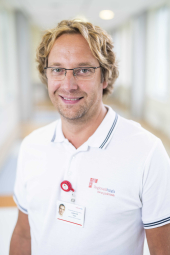Our staff
Five surgeons and two cardiologists work in the department. Various stages of the patient's treatment process also entail cardio-anaesthesiologists, operating room nurses, cardiac intensive care doctors, physical therapists and a host of other specialists. Only the joint efforts of a qualified team ensures a desired outcome and patient satisfaction.
The most common operations at the cardiac surgery department:
Coronary artery bypass graft (CABG)
Arterial calcification causes a deficiency in blood and oxygen supply in the cardiac muscle. In the case of CABG, critical blockages to blood flow in the coronary arteries are bypassed with the patient's own blood vessel, using veins or arteries for a bypass. Usually these are taken from the patient's own chest cavity, leg or arm. The operation alleviates stenocardia, improves the patient's quality of life and often increases life span. The bypass operation can be conducted in two ways:
- Cardiopulmonary bypass, using artificial blood circulation - ensuring the best conditions for the surgeon to connect blood vessels or for internal cleaning (endarterectomy).
- Beating heart surgery (off-pump), artificial blood circulation support if necessary - minimal manipulation in the case of serious atherosclerosis (non-touch technique), which reduces the probability of embolic complications. Therefore, the method is most suitable for elderly patients. There is no universal bypass method, however, and the final plan is made on an individual basis taking many circumstances into account.
Valvular heart disease
Replacing heart valves with an prosthetic valve requires open heart surgery, in which case the heart is stopped and chambers are opened. The patient's vital functions are maintained through artificial blood circulation. Usually a damaged valve must be replaced with an artificial valve. Today we use two types of prostheses.
- Mechanical prosthesis
It's structure is very durable and rarely causes thromboembolic complications. The excellent durability and good hemodynamic indicators make this prosthesis the best suited type for younger patients. The only major deficiency of the mechanical prosthesis is anticoagulation i.e. blood-thinning necessity. In other words, following the operation the patient must continuously inhibit coagulation with warfarin (Marevan), which requires periodic coagulation control. For the patient, this primarily involves a certain discomfort, rather than limitations. Today's mechanical prostheses allow for thicker blood, due to which the risk of anticoagulation-related bleeding is very small.
- Bio-prosthesis
Bio-prostheses are increasingly becoming a substitute for mechanical valve prostheses. These are taken either from swine or constructed from a calf's heart sac i.e. pericardium. The primary benefit of the bio-prosthesis is its easier post-surgical anti-thrombotic treatment (orally ingested aspirin without coagulation control is sufficient). Although the product development industry has reached the third generation valve, a satisfactory solution has not been found for the premature degeneration of the bio-prosthesis and consequently repeat surgery may be required. In the case of the smaller valve sizes, the pericardial prosthesis has better hemodynamic characteristics than the swine valves. The final decision on the type of prosthesis is always a patient-centred one that takes all circumstances into account.
Valvuloplasty
In rarer cases, it is possible to preserve a damaged heart valve and restore its normal function using various techniques and assisting materials (annuloplasty ring, artificial chordae tendineae). In recent years, an alternative has been developed for the traditional valve replacement for aortal valve dysfunction - transcatheter aortic valve implantation. Those conducting the implantation may be surgeons or interventional cardiologists; the optimal method of implantation is patient-centred. Initially, this procedure is reserved for patients with a very high risks in regular surgery.
Combination of heart defects
It is often the case, especially among older patients, that there is both a narrowing of arteries as well as a damaged heart valve. In such instances, it is reasonable to solve both problems in one stage, with the longer surgery compensated by a better final outcome.
Follow-up surgery
Follow-up heart surgery is possible for both patients of bypass surgery and valve replacement surgery. As a major challenge for the surgeon, the new outcome may not differ significantly from that of the initial surgery. Some patients may receive help from invasive cardiologists in expanding/stenting narrowing bypasses.
Surgical treatment of atrial fibrillation
If atrial fibrillation exists in addition to artery narrowing or valvular pathology that requires operation, the surgeon may treat it simultaneously by using the ablation procedure. It is rare as a separate surgery.
Treating internal heart defects
atrial septal defect (congenital)
ventricular septal rupture (complication of myocardial infarction)

